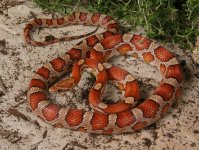This question is primarily for Carol, but anyone with a lot of experience with Miami-phase hatchlings, please feel free to chime in. This year I bred a nice Miami-phase female (silver background, red saddles, thick black borders) to a Miami-phase male het hypo (thinner borders, with more of a tannish background). Some of the hatchlings look almost anery -- silver background with very dark saddles (with just a tiny hint of red) -- while others look more like normals (still pale backgrounds, but with red/brown saddles). Carol, I think I remember you mentioning in a post some time back that the best Miami hatchlings (the ones that mature with the reddest, not orangish, saddles) are the ones that have really dark saddles at birth. Is that correct?
-
Hello!
Either you have not registered on this site yet, or you are registered but have not logged in. In either case, you will not be able to use the full functionality of this site until you have registered, and then logged in after your registration has been approved.
Registration is FREE, so please register so you can participate instead of remaining a lurker....
Please be certain that the location field is correctly filled out when you register. All registrations that appear to be bogus will be rejected. Which means that if your location field does NOT match the actual location of your registration IP address, then your registration will be rejected.
Sorry about the strictness of this requirement, but it is necessary to block spammers and scammers at the door as much as possible.
Carol -- Miami hatchling ??s
- Thread starter SnakeNutt
- Start date

